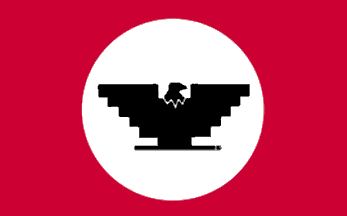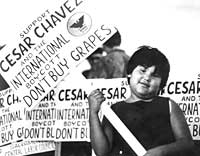During my investigation and analysis of the United Farm Workers, I began considering the option that while the UFW utilized society to cause change, it may not necessarily be a social movement. After examination, I conclude that the UFW's movement was not one of societal change, but a call to fix an industry, or an "industrial movement."
What would classify a social movement for me is a movement that attempts to tackle a very large social problem in a defined area, usually an effort made by citizens of a country. It needs to tackle a larger social issue that is, by nature, reflective of human and societal viewpoints.
However, the UFW was not a nationwide call for societal change, but rather had a list of demands that they felt they deserved. It wasn't truly designed to fix a bias or particular viewpoint, but rather called for a direct change in an unfair and small system. The UFW's demands were incredibly specific and were not related to treatment by a society, but by an unfair industry. This is reflected in how they market their cause as well as the internal/external communication they use to gather support.
External movement
Imagery



These images help to direct a very concrete message while also developing a sense of potential danger or importance. All of these images are quite to-the-point and use fairly intense colors and designs to help make them feel important.
Specifically the first two, they have very direct messages that are given more importance by their images. The bright colors, realism, and blood coming from the hands/grapes give the poster a sense of potential danger. When paired with the very simple and easy to read message, it's very well understood that we should follow it's message. The second one follows a similar line of thinking, with an image of blood on the grapes to pair with the direct quotation from Chavez. Again, bright colors that stand out, easy to read text, and a sense of intensity and even danger from the image pairs with a simple message.
The last image, the UFW flag, is important in it's own regard. It follows a similar line of thinking with simple, bright imagery that people will remember and associate with importance. What's important to note however, is that both this and the first image have connections to Mayan/Aztec culture (or at least lead the audience to draw that distinction.) This associates them with a culture and sense of community the UFW may otherwise lack, despite the organization not referencing racial inequality during the movement; simply the treatment of migrant farm workers.
Demands

The way the UFW makes demands is very simple and to-the-point, much like most of their imagery. They tend to rely on facts and easy to understand values to make their claims and demands.
In the text in the grape image above, they use very simple facts that make the audience understand the workers as suffering (some examples: "Farm work is the nations 3rd most hazardous industry," "The average lifespan of a farmworker is 49 years old," "Who can afford hospital care on an average income of $1,885 a year?) This form of associating farm workers with suffering is also paired with views of justice, specifically in regards to the treatment of the average farm worker to the average American. They help show the inequality of how the industry treats the farm worker and uses it as a call to action.
However, their demands are remarkably simple. Boycott table grapes, Gallo Wine, and any wine made in Modesto, California. This incredibly easy set of steps to follow makes helping the movement incredibly easy. They also call for very simple ways that their working environment will be made better, such as higher wages, adequate housing, access to proper sanitation, restrooms in the field, etc.
These demands and ways to help are remarkably simple and immediately contradict what is immediately thought of when thinking of social movements, especially during this time frame. It provided a simple, easy to understand, and seemingly achievable may to solve a major issue in an industry. This is opposed to the very complex and occasionally confrontational/dangerous sounding movements such as the Civil Rights movement or the Anti-War movement.
These other movements made the issues seem as though they may never be solved and even scary/earth-shattering to those locked in old, non-progressive thought processes. They were dangerous and unattainable. However, with easy messages and simple answers, the UFW's demands were seen as righteous and attainable to all (except for industry leaders.) It was easy to get behind because it was easy to fix.
Internal movement
The internal movement was much the same in terms of identity but tended to rely more on justice claims than listed above. They used values of justice, equality, and freedom to rally farm workers to their side while also providing a sense of community. The fact that they were being recognized as individuals while also being marked as a larger group (via specific imagery, using Spanish, etc.) made people excited to become involved and made them willing to call out for their freedoms against the industry they had been squashed by.
Mostly in the internal movement but also used in the external movement as ways of justification were ideas similar to racial inequality. Let's reference "Resisting Whiteness;" while the UFW isn't directly using race to show inequality, many of the same concepts still apply.
The migrant farm workers are shown to suffer a similar fate to minorities under a white culture. Under a dominating system, the workers lack a proper voice, are treated unjustly, and are suffering as a result. The system is literally killing them but they can't do anything about it. They call themselves oppressed and deserving of a certain treatment, therefore resisting the dominant culture. The loss of human rights isn't only about their treatment, but the idea that their needs are less important than that of a more powerful majority.
Of course, this is very similar argumentation to that of the Civil Rights movement and many other movements before it. While usually used sparingly in the external movement, it's very commonly used to gather other migrant workers to support the cause. The movement did not center around race or a societal change, but was able to associate a similar rhetoric to their call for change in an industry where the workers were being oppressed by the industry leaders.
Conclusion
The UFW did not run a social movement, but rather an industrial movement. They focused on change in an industry but required change to occur via outsiders. Therefore, they needed an easy to understand rhetoric that both from workers and the general public could understand. They used easy to understand values and facts to get people on their side. They also used a cultural element to give them a particular identity that could be associated with them but not define them. Furthermore, they utilized simple claims and ways of helping to juxtapose them to social movements that made the movement seem achievable and non-threatening to the general public.
No comments:
Post a Comment